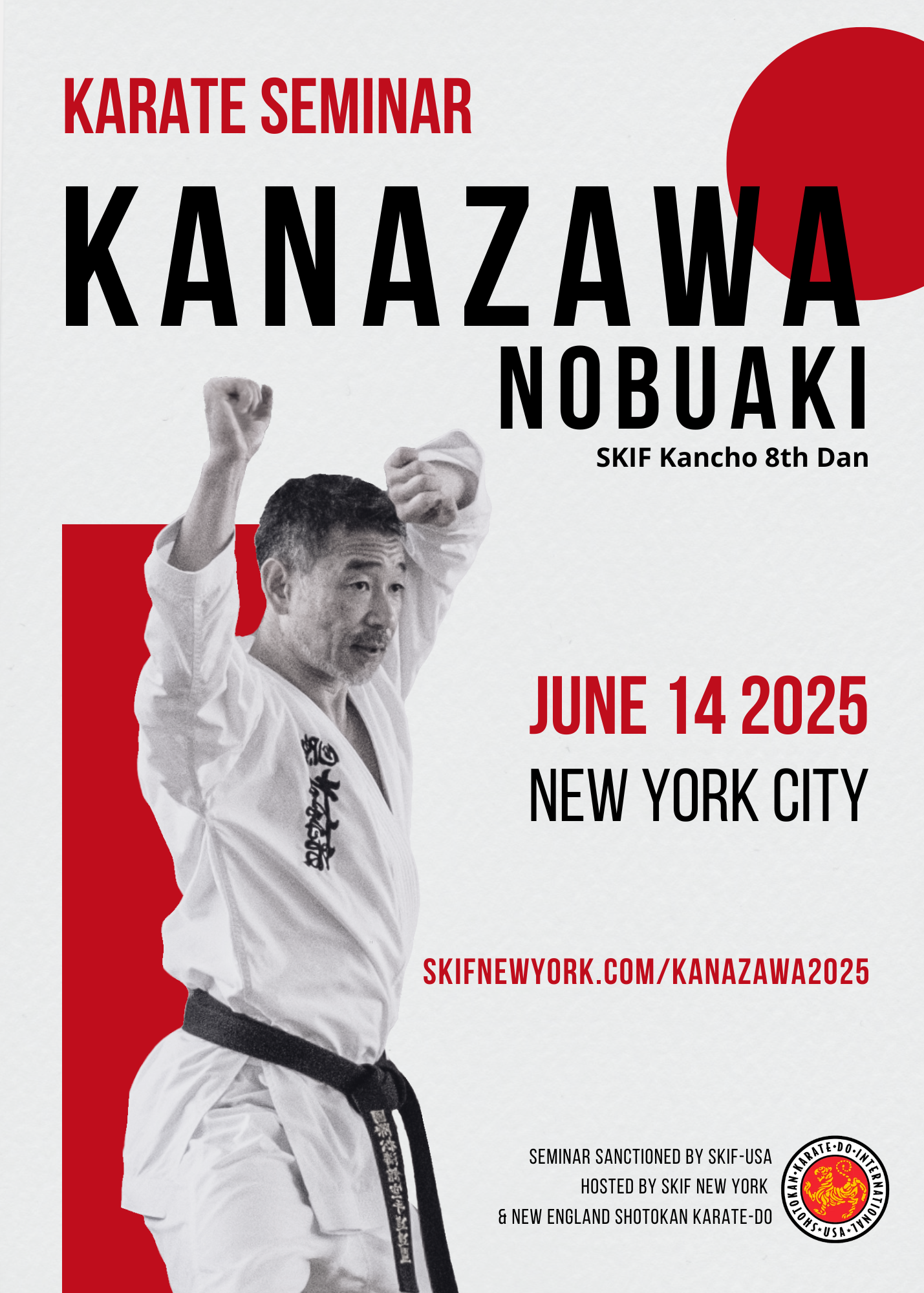SKIF New York
At SKIF New York we practice, study and promote Karate as martial art in its traditional form, fostering harmony with oneself and with the surrounding world.
As a SKIF member dojo, we follow sensei Kanazawa’s teachings and to pass them on to you.
Hirokazu Kanazawa
Hirokazu Kanazawa, who studied under Gichin Funakoshi, the founder of Shōtōkan Karate, and sensei Nakayama, where he became a prominent instructor of the Japan Karate Association. He was the first All-Japan Karate Championship kumite champion, in 1957, while nursing a broken wrist. The following year he repeated the feat by winning on both kumite and kata.
Kanazawa founded the Shotokan Karate-Do International Federation in 1978. Within his organization, he established a pedagogical system that allows Karate to be practiced and enjoyed by everyone, regardless of gender, age, or level of fitness. His method provides special attention to breathing and relaxation. It is also Kanazawa’s perspective that his style is only one out of a number of different ways to achieve Karate’s true meaning. He holds the rank of 10th Dan, and title of Sōke, or head of school. Beyond a Karateka extraordinaire, Kanazawa is also an amazing educator.
Adapted from skifworld.com

O-Sensei Gichin Funakoshi
Gichin Funakoshi was born in Shuri, Okinawa in 1868. As a boy, he was trained by two famous masters of that time, each trained him in a different Okinawan martial art. From Yasutsune Azato he learned Shuri-te, andfFrom Yasutsune Itosu, he learned Naha-te. It would be the melding of these two styles that would one day become Shotokan karate.
Funakoshi was a man of Tao. He placed no emphasis on competitions, record breaking or championships. He placed emphasis on individual self-perfection. He believe in the common decency and respect that one human being owed to another. He was the master of masters.
Adapted from skifworld.com

Dojo Etiquette
Remove all accessories (rings, earrings, bracelets, watches, etc).
Leave the shoes and socks outside of the training area.
Be mindful of your personal hygiene and the equipment’s cleanliness (start with the uniform).
Enter and exit facing the inside of the dojo, with a bow, and ask permission to the instructor.
Have the utmost respect for the practicing place, instructors (present or not), colleagues and yourself, regardless if a training session is currently ongoing.
Be silent during classes unless the instructor asks you something. When you speak, do it so in a low and respectful tone. Questions and observations should wait for the end of the class or done during breaks if it’s appropriate.
Pay maximum attention and effort during training.
Do not take stances that are disrespectful or carelessness, such as crossing your legs and/or arms, lean against the wall, or lay on the floor.
Must respect the class schedules. Entering a class late or leaving early should be avoided at all costs. If not possible, try to let the instructor know beforehand. Nevertheless, it is always preferred to attend a class partially than do not attend at all.
If coming in late, avoid disturbing the ongoing class, ask permission to enter the dojo, and wait in seiza (kneeling) for permission to take part of the class.
Use the restrooms before the beginning of the class to avoid interruptions.
Respect the senior students (senpai), and help and encourage the junior students (kohai).
Whenever you practice with someone else, bow at the beginning and at the end of each exercise.
Should not seek to be superior than your colleagues, but seek improvement of ourselves through correct principles
Should not use our martial arts knowledge to brag, impress or perform futile and unnecessary demonstrations.
Should not suspend or neglect the rest of our life activities, such as school or work, but learn how to manage time correctly.

Source: skifworld.com
Dojo Kun
-
1. SEEK PERFECTION OF CHARACTER
JINKAKU KANSEINI TSUTOMERU KOTO
一、人格 完成に 努める こと
-
1. BE SINCERE
MAKOTO NO MICHI O MAMORU KOTO
一、誠の道を守ること
-
1. PUT MAXIMUM EFFORT INTO EVERYTHING YOU DO
DORYOKU NO SEISHIN O YASHINAU KOTO
一、努力の精神を養うこと
-
1. RESPECT OTHERS
REIGI O OMONZURU KOTO
一、礼儀を重んずること
-
1. DEVELOP SELF CONTROL
KEKKI NO YUU O IMASHIMURU KOTO
一、血気の勇を戒むること
Contact Us
For more information please contact us via email or social media:






